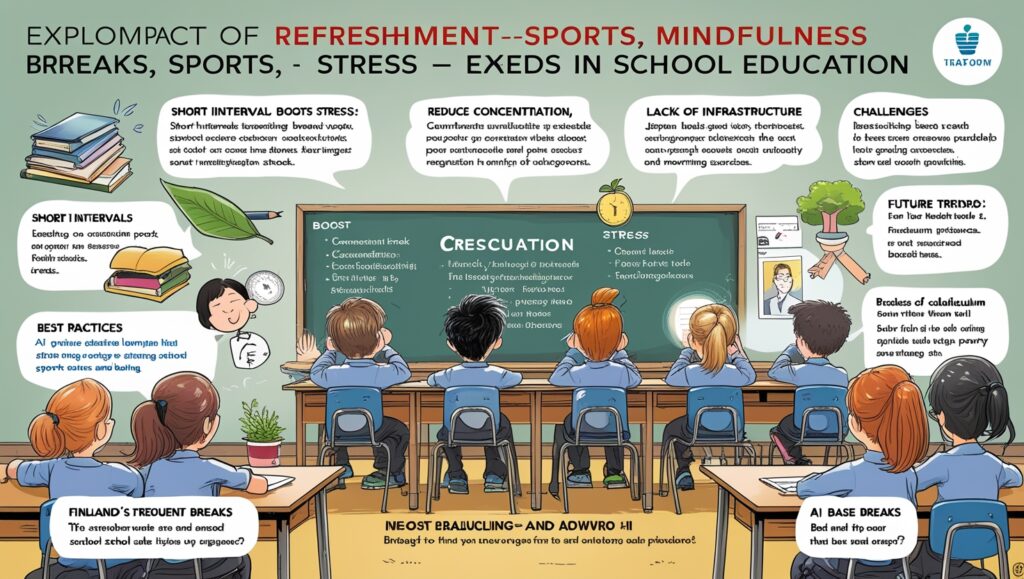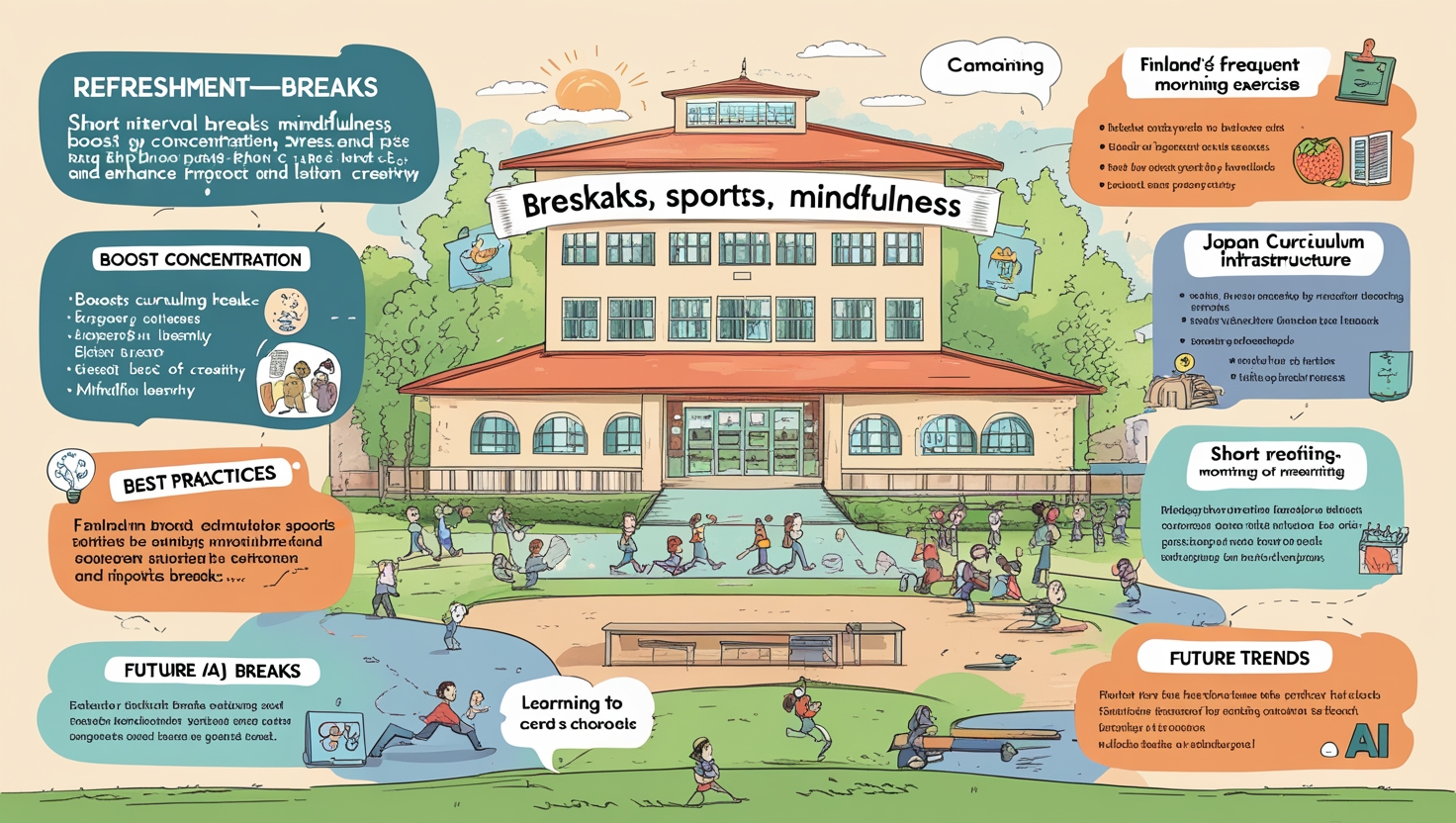Introduction
The Impact of Refreshment in School Education, Education is a dynamic process that requires continuous engagement, motivation, and energy from both students and teachers. One crucial yet often overlooked aspect of effective learning is refreshment—short breaks, recreational activities, and mental relaxation techniques that help rejuvenate the mind and body. In the modern education system, where students face increasing academic pressure, the role of refreshment has become more significant than ever.
This article explores the impact of refreshment in school education, discussing its benefits, different forms, challenges in implementation, and best practices to integrate it effectively into the curriculum.
1. The Concept of Refreshment in Education
Refreshment in education refers to planned or spontaneous breaks, leisure activities, and relaxation techniques that help students and teachers recharge their mental and physical energy. These can include:
- Short breaks between classes
- Recreational activities (sports, arts, music)
- Mindfulness exercises (meditation, deep breathing)
- Nap times or quiet periods
- Outdoor learning and nature walks
The primary goal is to reduce stress, enhance focus, and improve overall academic performance.
2. The Benefits of Refreshment in School Education
A. Improved Concentration and Cognitive Function
Research shows that the human brain can only maintain high focus for about 45-60 minutes at a time. Continuous studying without breaks leads to mental fatigue, reducing retention and comprehension. Short refreshment intervals help reset attention spans, leading to better learning outcomes.
B. Reduced Stress and Anxiety
Academic pressure, exams, and long study hours contribute to student burnout. Refreshment activities like yoga, meditation, or playful interactions help lower cortisol levels, promoting emotional well-being.
C. Enhanced Physical Health
Sitting for prolonged periods affects posture and circulation. Refreshment breaks that include stretching, sports, or walking improve blood flow, reduce eye strain, and prevent obesity-related issues.
D. Boosted Creativity and Problem-Solving Skills
Moments of relaxation stimulate divergent thinking. Activities like drawing, storytelling, or free play encourage creativity, helping students approach problems innovatively.
E. Better Social Skills and Teamwork
Group refreshment activities (team sports, collaborative games) foster communication, leadership, and cooperation among students, which are essential life skills.
F. Increased Motivation and Engagement
Monotonous routines lead to disinterest. Fun breaks make learning enjoyable, keeping students motivated and eager to participate in class.
3. Forms of Refreshment in Schools
Different schools adopt various refreshment strategies based on their resources and student needs. Some effective methods include:
A. Short Breaks Between Classes
- 5-10 minute breaks after every 45-50 minutes of instruction.
- Encouraging students to walk, stretch, or engage in light conversation.

B. Physical Activities (Sports & Games)
- Morning exercises or yoga sessions.
- Sports periods (football, basketball, badminton).
- Dance and aerobics for fun physical engagement.
C. Mindfulness and Relaxation Techniques
- Guided meditation sessions.
- Deep breathing exercises before exams.
- Quiet reading or nap time for younger students.
D. Creative and Artistic Refreshment
- Art and craft sessions.
- Music and drama clubs.
- Storytelling and poetry recitation.
E. Outdoor and Nature-Based Learning
- Field trips to parks, museums, or botanical gardens.
- Gardening clubs where students grow plants.
- Nature walks for environmental education.
4. Challenges in Implementing Refreshment in Schools
Despite its benefits, integrating refreshment into school schedules faces several challenges:
A. Curriculum Pressure
Many schools prioritize syllabus completion over breaks, fearing delays in academic progress.
B. Lack of Infrastructure
Some institutions lack playgrounds, sports equipment, or meditation spaces, limiting refreshment options.
C. Resistance from Traditional Mindsets
Parents and educators sometimes view breaks as “wasted time”, believing more study hours directly translate to better grades.
D. Overemphasis on Digital Entertainment
While technology can be refreshing, excessive screen time during breaks (mobile games, social media) can be counterproductive.

5. Best Practices for Effective Refreshment in Schools
To maximize the benefits of refreshment, schools should adopt structured yet flexible approaches:
A. Scheduled Breaks with Purpose
- Short breaks (5-10 minutes) for stretching or chatting.
- Longer breaks (20-30 minutes) for sports or creative activities.
B. Teacher Training on Refreshment Techniques
- Workshops on mindfulness, classroom energizers, and stress management.
C. Parental Awareness Programs
- Educating parents on the science behind refreshment and its academic benefits.
D. Balanced Use of Technology
- Encouraging offline games, puzzles, and group activities over excessive screen time.
E. Student Feedback and Customization
- Allowing students to choose preferred refreshment activities based on their interests.
6. Case Studies: Schools Excelling in Refreshment Practices
A. Finland’s Education Model
- Famous for 15-minute breaks after every 45 minutes of class.
- Emphasizes play-based learning and outdoor activities.
B. Japan’s “Radio Taiso” Morning Exercises
- Schools conduct group calisthenics to boost energy and unity.
C. Indian Schools Incorporating Yoga & Meditation
- Many institutions start the day with yoga and mindfulness sessions, improving focus.
7. The Future of Refreshment in Education
As education evolves, refreshment will play an even bigger role, with trends like:
- AI-based personalized break reminders.
- Virtual reality relaxation zones.
- More research on optimal break durations.
Schools must balance academics and well-being to nurture holistically developed individuals.
Conclusion
Refreshment is not a distraction but a necessity in modern education. It enhances learning efficiency, reduces stress, and fosters creativity. By integrating structured breaks, physical activities, and mindfulness practices, schools can create a healthier, happier, and more productive learning environment. The key lies in recognizing refreshment as an essential component of education, not an optional luxury. Schools, teachers, and parents must collaborate to ensure that students get the right balance of study and relaxation for long-term success.

Every time I visit your website, I’m greeted with thought-provoking content and impeccable writing. You truly have a gift for articulating complex ideas in a clear and engaging manner.
https://t.me/s/Official_1win_kanal/1110
Официальный Telegram канал 1win Casinо. Казинo и ставки от 1вин. Фриспины, актуальное зеркало официального сайта 1 win. Регистрируйся в ван вин, соверши вход в один вин, получай бонус используя промокод и начните играть на реальные деньги.
https://t.me/s/Official_1win_kanal/4471
I am noo lonfer sure where you are getting your information, but great
topic. I needs to spend some time studying much more or
figuring outt more. Thanks for great info I was in search of this information for my mission. https://hallofgodsinglassi.wordpress.com/